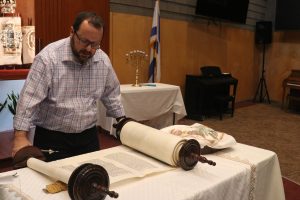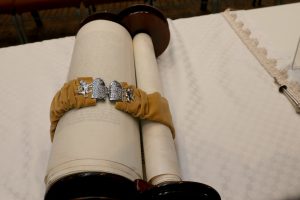- Slug: BC-CNS-Jewish High Holy Days. 600 words.
- 2 photos available (thumbnails and captions below).
- Video available here.
- Chart available here.
By Jacob Snelgrove
Cronkite News
PHOENIX – Yom Kippur, which began Sunday and ended Monday at sunset, is one of the most important holidays in Jewish faith, but Arizonans looking for a synagogue to observe Yom Kippur might have to commute.
The Jewish population in Maricopa County grew by nearly 20% from 2002 to 2019, according to an Arizona State University study done in 2019. But leaders in the Jewish community say the proliferation of synagogues – with most in Scottsdale and north Phoenix – hasn’t kept up with the growth of the Jewish population.
“Unlike other religions where they have centralized organizations that sort of plant churches where they go and look and see where there is a need. Then the central organization plants a church. Synagogues are more bottom-up organizing. It’s where wherever there is a critical mass of Jews who self-organize to start a synagogue. That’s what determines where a synagogue is going to be located,” said Rabbi Cookie Lea Olshein of the Temple Emanuel of Tempe.
But if there aren’t enough Jewish people dedicated to forming a synagogue in an area, there most likely won’t be one nearby.
“I’m not sure we will see more formal synagogues in the near future. It takes people really committed to creating organizations, and it’s just really hard to do that,” Olshein said. “Hopefully we will continue to see small groups of Jews continue to self-organize into what are called chavurah, which are friendship-based groups of Jews that come together for Jewish purposes.”
Yom Kippur, known as the Day of Atonement, marks the culmination of the High Holy Days. In Jewish tradition, this is a period of introspection and repentance that follows the Jewish new year, Rosh Hashana.
Yom Kippur is observed with a 25-hour fast, worship and time of reflection – often at a synagogue. The fast is broken with friends and family gathering to eat together at sundown.
Jeremy Schneider is a rabbi at Temple Kol Ami in Scottsdale, and he has seen his congregation grow from 100 families to nearly 400 families in the past decade.
The 2019 ASU study estimated 98,750 people in Maricopa County were Jewish, 2.36% of the county population at the time. Study authors noted the difficulty of providing an accurate count given Judaism is both an ethnicity and a religion.
“When I arrived in the community 12 years ago, one of the first things I started at the congregation was online Jewish learning or online Hebrew school,” Schneider said, and the synagogue still offers virtual prayer.
Olshein said you don’t need to be close to a synagogue to celebrate holidays or worship.
“We’re still using Zoom technology to allow people to interact remotely with people in the sanctuary,” Olshein said. “It does take a commitment for someone to drive 30 minutes to a worship service, but hopefully we provide value when people come, especially in terms of community that make it worth the drive.”
Arizona State University students who are interested in the Jewish faith have worship opportunities on campus.
The Hillel Jewish Student Center at ASU is a Jewish campus organization that aims to enrich the lives of Jewish students. The organization estimates ASU has 3,500 Jewish students.
Jessica Cadmus is an ASU undergraduate student who is a part of the ASU Hillel board and a member of Alpha Epsilon Phi, a Jewish sorority.
“There’s not a synagogue that is walking distance so I couldn’t necessarily go to one if I wanted to, but I found a great Jewish community with Hillel. I definitely feel there is a strong Jewish community here at ASU,” Cadmus said.
For more stories from Cronkite News, visit cronkitenews.azpbs.org.

